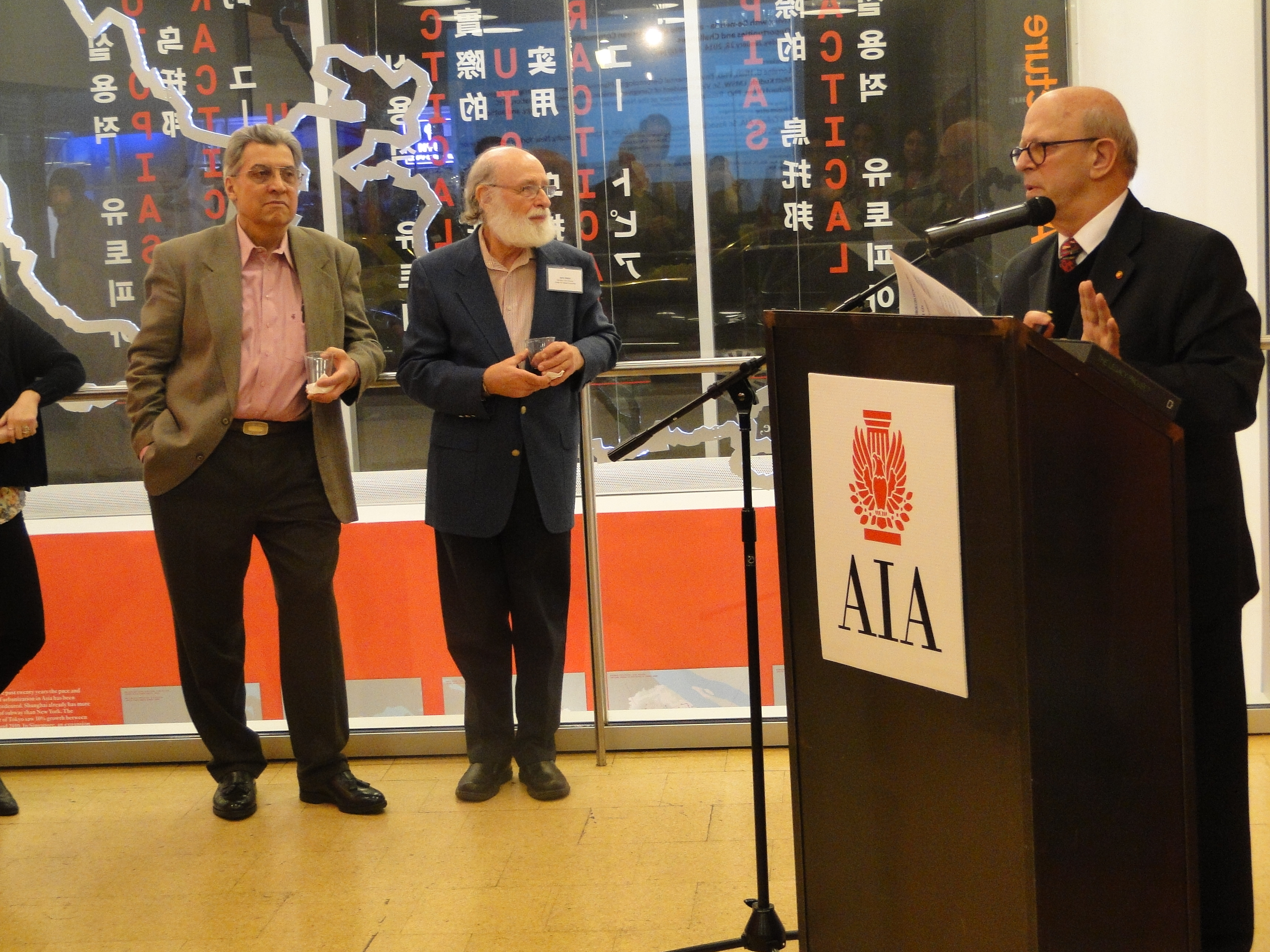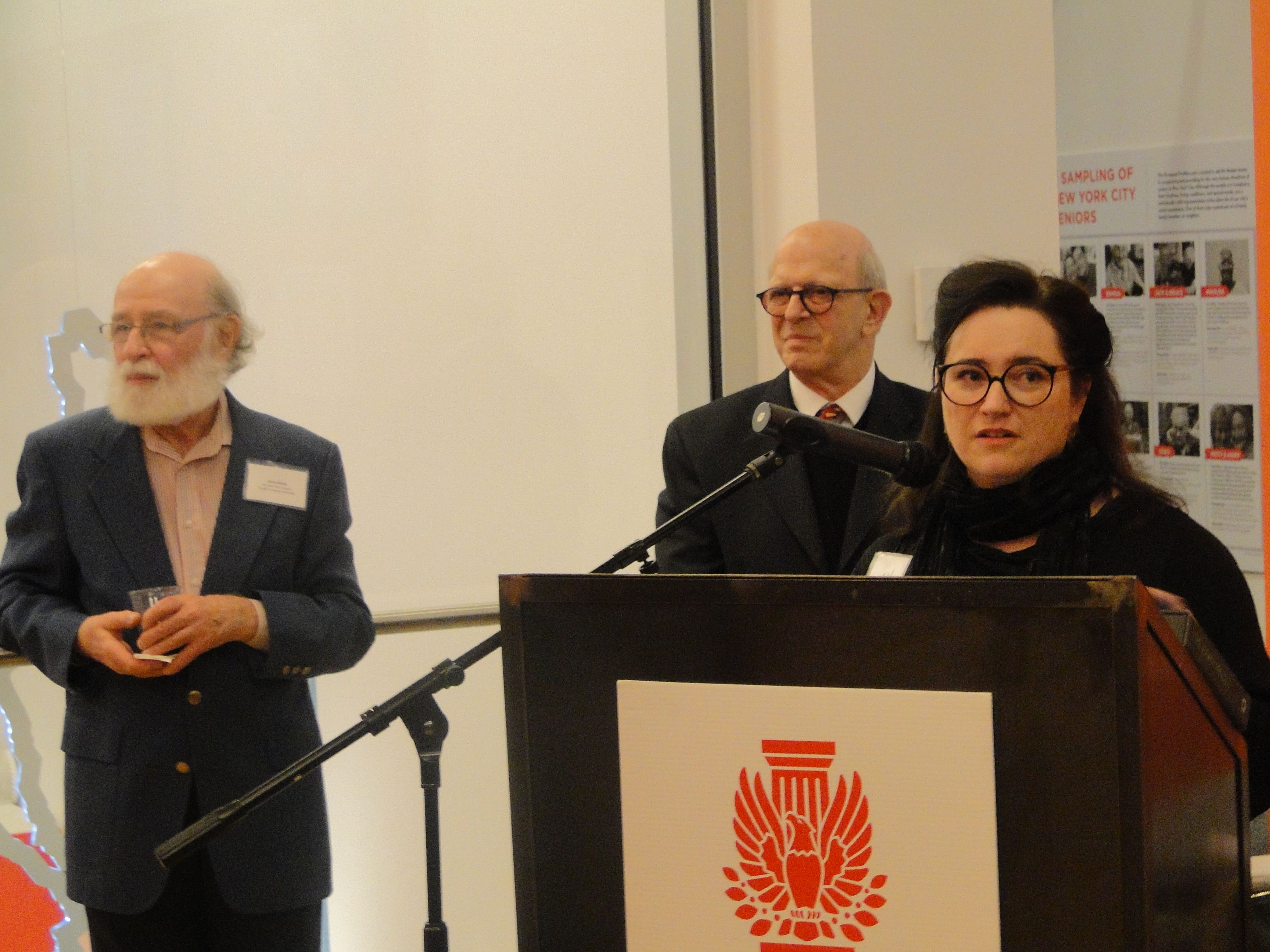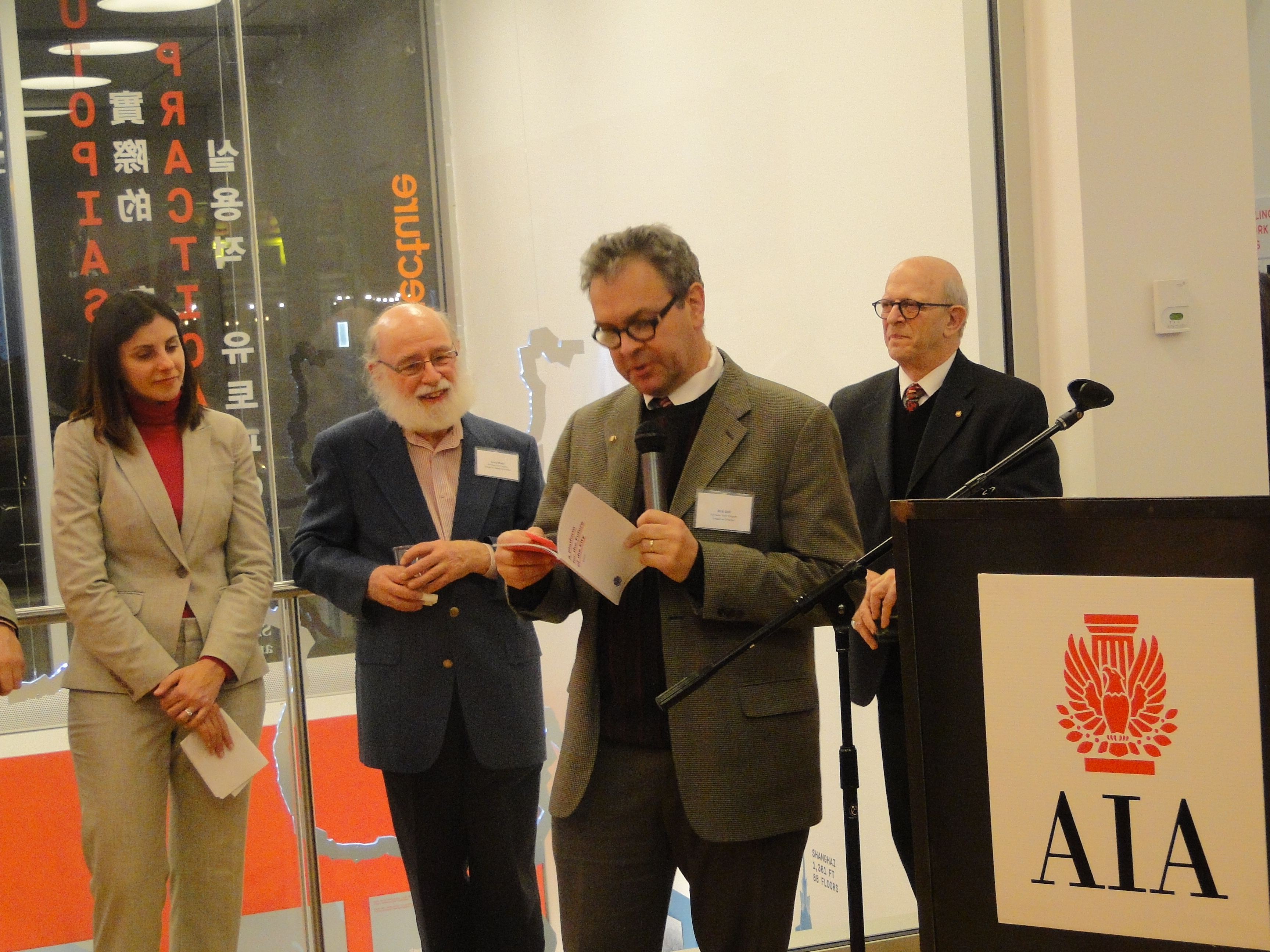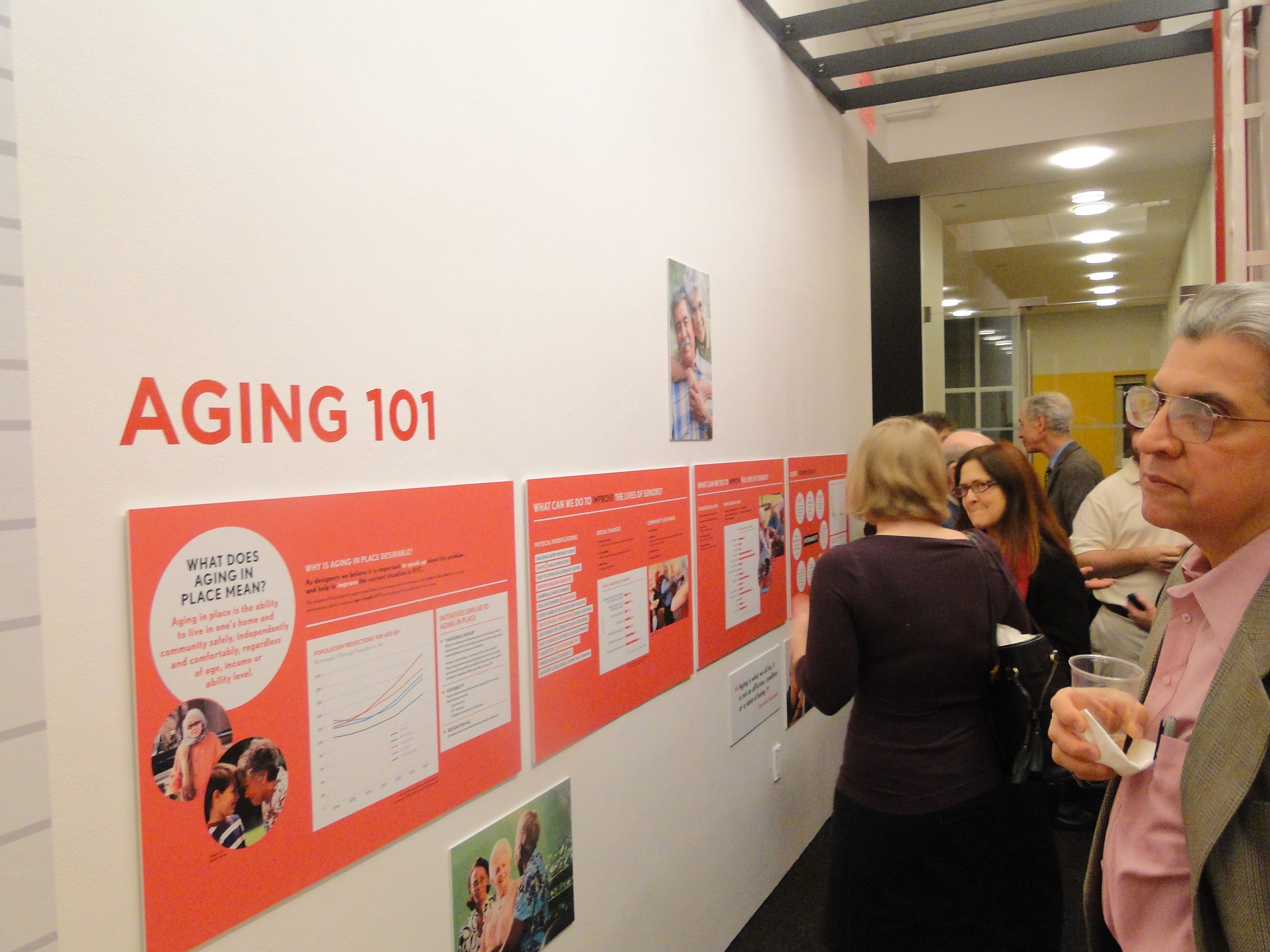by: Claire Webb
Riding my bike on the West Side Highway to the exhibition opening of “Booming Boroughs: Redesigning Aging-in-Place in NYC” at the Center for Architecture, I passed an ad for starting a retirement account: “The person who will live to be 131 is alive today.” Though a little ominous, the ad seemed auspiciously fitting – priming me to think about how the idea of aging must be reexamined.
The exhibition lays out the challenges facing aging people in NYC: most are renters; the city’s old buildings are ill-equipped to cater to seniors; and most seniors live on a fixed income. So, staying in one’s home or adapting to a new senior-living environment can be tough. Presented throughout “Booming Boroughs” is the idea that choice is very important to seniors. Another compelling touchpoint is the quote: “Aging is what we all do; it is not an affliction, condition, or state of being.” This highlights an uncomfortable, often unspoken notion that the exhibition implicitly addresses: In our city, where the integral value is diversity, we need to move beyond shunning just racism and sexism, but also confront ageism through articulated, meaningful ways.
A charrette, organized by the AIANY Design for Aging Committee last May, was the anchor of the exhibition. Architects, designers, social workers, and seniors met at the Center for a day-long intensive study. This interdisciplinary session approached many characteristics of aging in the city, allowing for diverse solutions. The charrette cleverly broke off into groups not divided by boroughs, but by scale: SMLXL. By rejecting a one-size-fits-all structure, the groups tackled design problems that permeate all city neighborhoods.
A thread running through “Booming Boroughs” is that designing for aging-in-place must transcend physical adaptation to facilitate social scenarios. This goal must be balanced with the perennial challenge of our city: how do we design with what we have? Single apartments (S) could take on flexible living spaces with movable partitions; seniors could still access necessities like medicine and personal effects. The group that handled low- and mid-rise apartments (M) recommended retrofitting stoops to better accommodate seniors. Another group (L) used Amsterdam Houses, an NYC Housing Authority project, as a focal point for improving community in high-rises: shared kitchens could trigger group cooking, “front porches” could be places for informal gathering, and reworking floor plans for co-housing could cement truly social living. Adaptive reuse (XL) could repurpose brownfields and industrial sites to create communities where aging-in-place could be built in. Members of the Big Idea group brought personal experiences to how we age in NYC: end-of-life planning, an essential task but often left undone, should be implemented honestly and assertively, and block mayors could lend a stronger voice to group concerns.
The exhibition addresses challenges of aging specific to New York City, but also engages larger, more global issues. The SMLXL approach fittingly maps our diverse buildings types, and we should consider how this framework might benefit from design solutions elsewhere, especially Asian cities. These tensions between ideas and implementation are made especially pertinent because the Center’s concurrent exhibit, “Practical Utopias,” which paints a futuristic landscape of high-tech development in Hong Kong, Singapore, and Tokyo. Obviously, the urban texture here is much different than in countries like China, where, in terms of population, NYC might be considered a small city. But the cultural terrain is unlike the U.S.’s. The pernicious yet unspoken notion that we in the U.S. do not particularly put a high value on aging is completely against the cultural grain in countries like Japan. We could learn a lot from a system that places a premium on keeping families together as the oldest generation ages. In our dense cities, as in Asia, there’s only one way to build – up – and we can see how they blend similar urban texture that allows for senior living.
In a short speech, Beatriz de la Torre, Commissioner of Strategy and Operations at the NYC Department of Housing Preservation and Development, noted that seniors are the fastest growing population in the U.S., underscoring the pressing call to action of the exhibition. A cousin to this phenomenon – and another point of insight to expand the exhibition’s narrative – is that women baby-boomers, moving into the “senior” category, are the fastest growing group to use technology with social media. The charrette explored unexpected ways in which seniors might use technology in their homes for safety. Expanding this, we could integrate social media into senior living in an aggressive, conscientious way. Folding this nuance into the charrette’s findings would enrich design solutions for making seniors’ homes ever more tech-enabled.
These recommendations touch on the larger question of “who is a senior?” Age and ability are correlated, of course, but they need not be synonymous as healthcare expands and design solutions for aging-in-place are implemented. As our conception of how we “should” age evolves, a touchstone could be that good design for seniors is good design for all of us. As tech amenities morph into necessities and the tech-fluent generation ages, for example, it’s clear that creating infrastructure now is an investment not just for older loved ones, but for ourselves. This viewpoint, highlighted by the exhibition, is something most of us would readily agree to, although it may not be immediately obvious. This is especially resonant because, for all of us, these issues are not so far away.
Claire Webb studied astronomy and philosophy at Vassar College, but an interest in art history and architecture led her to the position of Marketing Director at Edelman Sultan Knox Wood / Architects.
Event: Exhibition Opening | Booming Boroughs: Redesigning Aging-in-Place in NYC
Location: Center for Architecture, 01.09.14
Speakers: Lance Jay Brown, FAIA, 2014 AIANY President; Beatriz de la Torre, Commissioner of Strategy and Operations, NYC Department of Housing Preservation and Development; Jerry Maltz, AIA, Co-chair, AIANY Design for Aging Committee; Lisa Morgenroth, Co-chair, AIANY Design for Aging Committee; and Rick Bell, FAIA, AIANY Executive Director
Organized by: AIANY Design for Aging Committee and the Center for Architecture
Sponsors: Rose Associates, Inc.; Thronburg Foundation; Ethelind Coblin Architect (Lead Sponsors); Capsys Corporation; AARP New York; James Hardie Building Products; SKA Marin; Hamlin Ventures; Hollwich Kushner; NYS Builders Association Research & Education Foundation; OMNI Architects (Supporters and Friends); The Design Gym; HAFELE; KIND Healthy Snacks; Mayor’s Office for People with Disabilities; and REED Construction Data (In-Kind Services and Donations)














